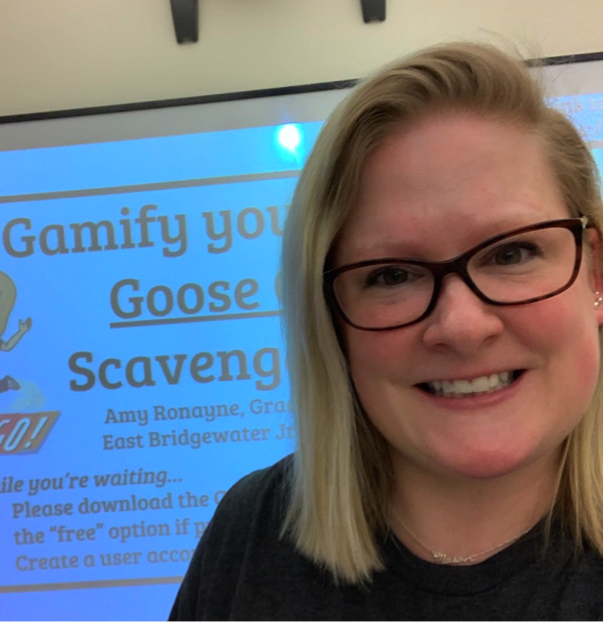Meet Amy Ronayne!

Amy Ronayne is a Grade 8 English Language Arts teacher at East Bridgewater Junior/ Senior High School in East Bridgewater, Massachusetts. She has been sharing her love of the teaching profession for 10 years with her middle school students! She never has a boring day at work and has been implementing GooseChase into her lessons while sharing the platform with others. Ever since she first learned about GooseChase at the MassCUE fall conference, she has been such an amazing GooseChase Educator! Learn more about what Amy had to say below!
How have you used GooseChase?
I’ve used GooseChase to introduce topics and review concepts, but my favorite way is when students create the GooseChase games to show mastery of a topic or concept. I love seeing their excitement when they walk into class and know we will be playing a student- created game, and I can tell that students really “get it” by how well the missions are crafted and completed.
When do you think you’ll use GooseChase next?
Often, before starting a new unit, I will look at the rubric for the summative performance task. I then use what’s on the rubric to create missions for a GooseChase game. For example, for our personal narrative writing unit, the rubric includes using dialogue, description, and reflection in writing. I would then create a game with missions such as finding an example of descriptive writing, creating dialogue, and filming someone learning a lesson and reflecting. It’s an engaging way to introduce students to the new concepts before we dive deeper together.
What do you think makes GooseChase special?
GooseChase is special because it gives students the element of choice. If a mission asks them to take a picture of descriptive writing, they have the option to find the writing in a reading book of their choice, or they can create their own descriptive writing on paper (or on a whiteboard) and take a picture of that. They also have choice in the order in which they complete their missions. I always sprinkle in some fun, non-academic missions, too (such as film a team member doing 10 pushups) and students really enjoy the opportunity to showcase their other strengths in class. GooseChase is also special because it builds a sense of community by allowing students to work together as a team and compete for points (who doesn’t love a good competition?!). Lastly, I appreciate that GooseChase gets students up out of their seats and moving around the classroom and throughout the hallways. Students spend too much time sitting, and GooseChase gives them an opportunity to move around!
What tip(s) do you have for educators just getting started with GooseChase?
If you’re just getting started, go into the Game Library and try a game someone else has created! There are lots of amazing games that educators have shared, and when you see the excitement in your students as they play, it will give you the confidence to create your own game. When you do create your own game, I also highly recommend adding in some fun missions that aren’t necessarily academic. The fun missions build comradery and allow students to shine who may not be the strongest students in your particular subject. Also, it may be comforting to know that my students needed very little instructions on how to play GooseChase. They are so intuitive with technology that they figured it out very quickly, and the GooseChase platform is incredibly user-friendly.
Big thank you to Amy for taking some time to give her insight into using GooseChase! If you want to follow along with Amy and see the ways in which she uses GooseChase in her classroom, give her a follow on Twitter, @MrsRonayne!





